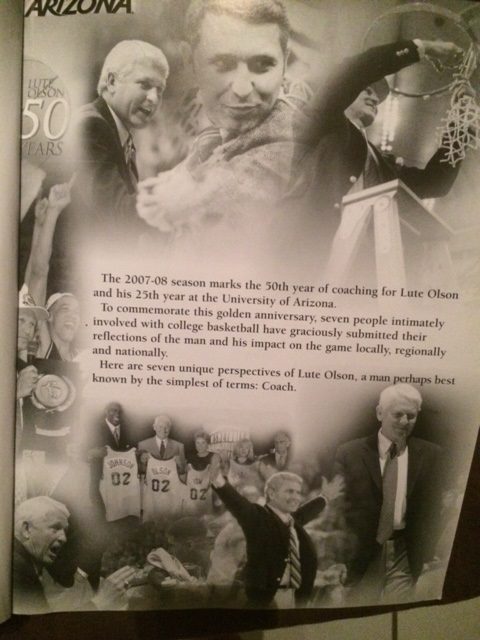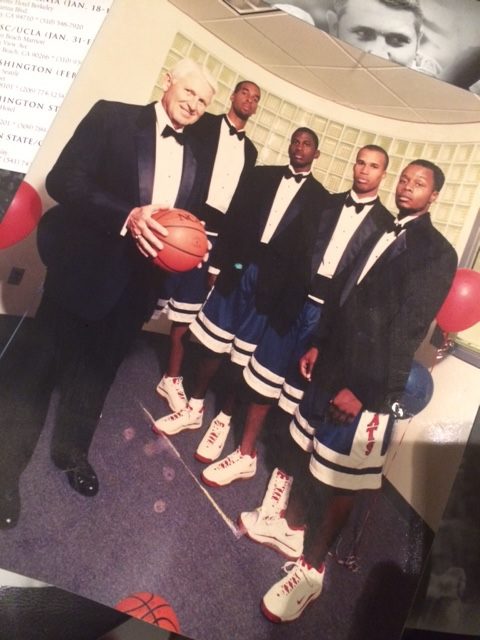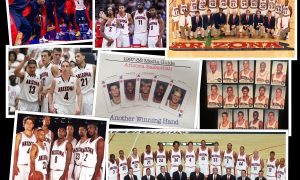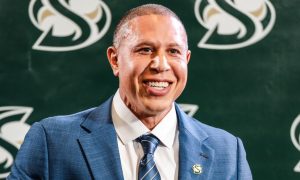Much of this column was written in 2007-08 when Lute Olson was celebrating his 50th year of coaching and 25th year as Arizona’s coach. It all still applies today.

A page on Lute Olson from the University of Arizona basketball media guide in 2007-08.
Who would have thunk it?
That the University of Arizona would be a basketball haven, where some of the best of the best talent would want to attend.
Come on, really?
Sure, Arizona, behind Fred Enke, became a respected program after World War II, having made college basketball’s postseason for the first time, continuing it through the early 1950s.
And sure, basketball resurfaced when Fred “The Fox” Snowden returned the Wildcats to postseason with some of Arizona’s best basketball in the mid-1970s.
But if Fred Enke started the success and Snowden re-established it, it was Robert Luther Olson who captured and simply defined it.
Lute – as most know him by that name in basketball circles and beyond – will be honored for all his accomplishments on Thursday, April 12 when UA unveils a statue in his honor. It’s fitting, of course, and well finally a reality.

Lute with Loren Woods, the late Michael Wright, Richard Jefferson and Rueben Douglas.
“It’s an honor that’s well deserved and long overdue,” said Pete Williams, often called “The Cornerstone” of Olson’s start in 1983 in as much as he was one of the first recruits.
Who would have thought all this was possible back in 1983 when then Arizona athletic director Cedric Dempsey sought Olson out that March night just moments after Iowa was eliminated from the NCAA tournament in Philadelphia? Dempsey saw something – some things – in Olson he liked, having watched him at his previous stops (Long Beach, Iowa).
Olson was a master builder, an of-court technician and a coach who got the most out of his players.
Eventually, Dempsey and Arizona got their man.
“One of our goals was for the program was to make it a top 10 one,” Dempsey told me about 10 years ago when this column originally ran. “I wanted someone who had the ability to take the program to a level of excellence.”
And voila, Olson did, and with such a meteoric rise. Unbelievably, he took Ben Lindsey’s 4-24 record and two years later had the Wildcats in the NCAA tournament for the first time since 1976-77.
The Old Pueblo was set to make its mark on the basketball map once again … this time with authority and eventually longevity. Blue Bloods beware.
Williams remembered it all too well. Then-assistant coach Scott Thompson had just picked up Williams at Tucson International Airport when a dust storm hit, and Williams turned to Thompson and said it appeared Lute & Co., “were on a mission to rebuild the program.”
Indeed.
Olson did – and then some. In a career that lasted 25 years at Arizona and 50 as a coach, he won more games than ever imagined. He coached UA to its first Final Four, 30 years to the month this year and three more after that. And, oh yes, there was that national title of 1997, when No. 4 seed Arizona did what many thought impossible or improbable … beat three No. 1 seeds en route to the title.
It had never been done before or has been done since.
“I’ve long said that Lute’s the Frank Lloyd Wright of coaching,” Dick Vitale told me back in 1997 for my first book. “He’s a builder of programs. If you look at his long-term record and what he’s done with the programs he’s been at, how can you not appreciate him? He’s created such interest in Tucson.”

Lute was long known to being a builder of programs.
It never really stopped. At the time of this column (back in 2007) Olson was one of only three coaches to have 29 or more 20-win seasons. He was one of only 16 coaches to have won more than 1,000 games throughout his career. He took UA to 23 consecutive NCAA tournaments, at the time the NCAA leader. And, of course, last but not least he was named to the Naismith Basketball Hall of Fame.
Who would have thunk it?
“I didn’t think it would be like this,” former UA star Steve Kerr, who at the time was the president and general manager of the Phoenix Suns. “I thought Lute would turn it around and we’d be an NCAA tournament team. He’d go out and build a good program, but I had no idea he’d do it to the extent he has.”
He adjusted. Throughout his career, he was a master at it. From getting his teams to overachieve in his early years to going from a big-man lineup for much of the early 1990s to its guard-oriented group a year or so later, Olson played to the team’s strengths.
“What he wanted to do is establish a program and a culture,” Kerr said back then. “He understands the power of team, that it’s much more than the talent.”


















